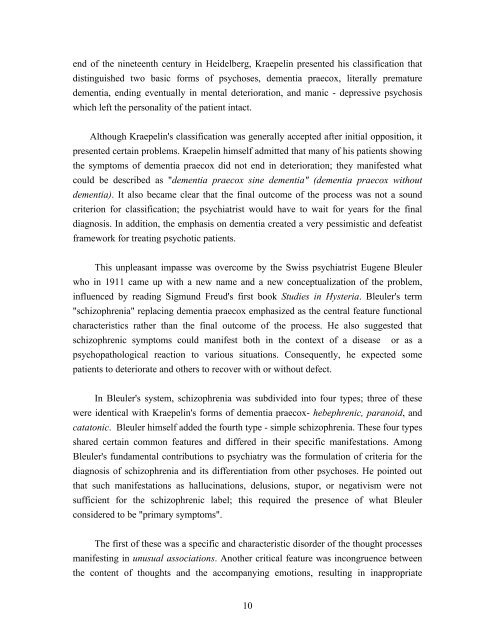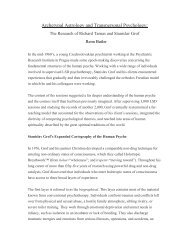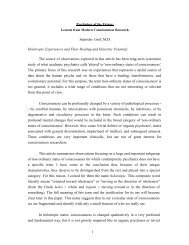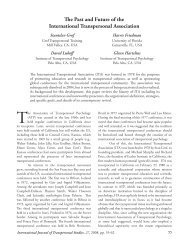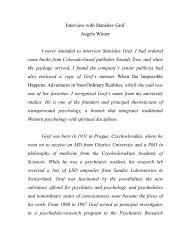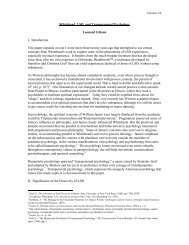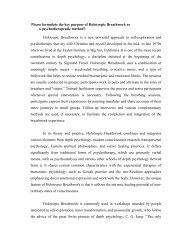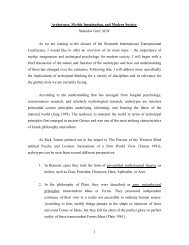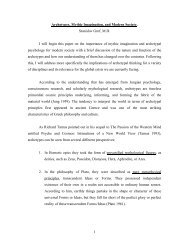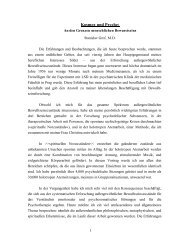1 PSYCHOSIS AND HUMAN SOCIETY: A Historical ... - Stanislav Grof
1 PSYCHOSIS AND HUMAN SOCIETY: A Historical ... - Stanislav Grof
1 PSYCHOSIS AND HUMAN SOCIETY: A Historical ... - Stanislav Grof
Create successful ePaper yourself
Turn your PDF publications into a flip-book with our unique Google optimized e-Paper software.
end of the nineteenth century in Heidelberg, Kraepelin presented his classification that<br />
distinguished two basic forms of psychoses, dementia praecox, literally premature<br />
dementia, ending eventually in mental deterioration, and manic - depressive psychosis<br />
which left the personality of the patient intact.<br />
Although Kraepelin's classification was generally accepted after initial opposition, it<br />
presented certain problems. Kraepelin himself admitted that many of his patients showing<br />
the symptoms of dementia praecox did not end in deterioration; they manifested what<br />
could be described as "dementia praecox sine dementia" (dementia praecox without<br />
dementia). It also became clear that the final outcome of the process was not a sound<br />
criterion for classification; the psychiatrist would have to wait for years for the final<br />
diagnosis. In addition, the emphasis on dementia created a very pessimistic and defeatist<br />
framework for treating psychotic patients.<br />
This unpleasant impasse was overcome by the Swiss psychiatrist Eugene Bleuler<br />
who in 1911 came up with a new name and a new conceptualization of the problem,<br />
influenced by reading Sigmund Freud's first book Studies in Hysteria. Bleuler's term<br />
"schizophrenia" replacing dementia praecox emphasized as the central feature functional<br />
characteristics rather than the final outcome of the process. He also suggested that<br />
schizophrenic symptoms could manifest both in the context of a disease or as a<br />
psychopathological reaction to various situations. Consequently, he expected some<br />
patients to deteriorate and others to recover with or without defect.<br />
In Bleuler's system, schizophrenia was subdivided into four types; three of these<br />
were identical with Kraepelin's forms of dementia praecox- hebephrenic, paranoid, and<br />
catatonic. Bleuler himself added the fourth type - simple schizophrenia. These four types<br />
shared certain common features and differed in their specific manifestations. Among<br />
Bleuler's fundamental contributions to psychiatry was the formulation of criteria for the<br />
diagnosis of schizophrenia and its differentiation from other psychoses. He pointed out<br />
that such manifestations as hallucinations, delusions, stupor, or negativism were not<br />
sufficient for the schizophrenic label; this required the presence of what Bleuler<br />
considered to be "primary symptoms".<br />
The first of these was a specific and characteristic disorder of the thought processes<br />
manifesting in unusual associations. Another critical feature was incongruence between<br />
the content of thoughts and the accompanying emotions, resulting in inappropriate<br />
10


